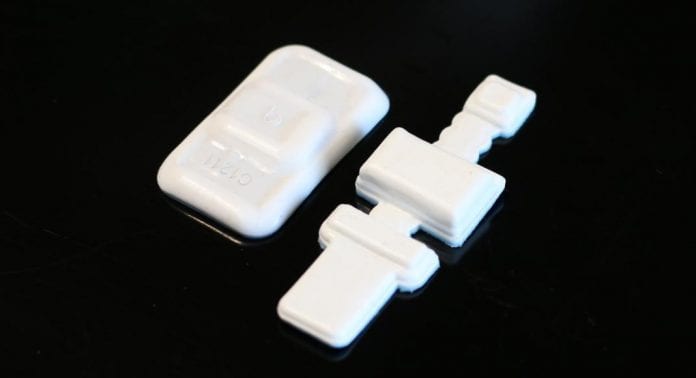
A group of scientists have developed a unique, remote monitoring device for COVID-19 that attaches to the throat to help fight the pandemic.
To detect early signs of COVID-19, researchers from Northwestern University have developed a wearable remote monitoring device and set of data algorithms specifically tailored to catch early signs and symptoms associated with COVID-19.
The device can monitor patients as the illness progresses and is about the size of a postage stamp. The soft, flexible, and wireless device is designed to sit below the suprasternal notch, the visible dip at the base of the throat which the scientists say is an ideal location for monitoring respiratory health.
The research team was led by bioelectronics pioneer John A. Rogers, and the paper is co-authored with Dr Shuai Xu, a Northwestern Medicine dermatologist, and Hyoyoung Jeong, a postdoctoral fellow in the Rogers lab. It has been published in the journal Science Advances.
Remote monitoring for COVID-19
The paper highlights that consumer health monitoring devices are not sophisticated enough to look for signs of COVID-19. The team have developed the novel, clinical grade device alongside a flexible pulse oximeter to pair with the suprasternal-mounted device. This allows physicians to continuously monitor for silent hypoxia, an often-asymptomatic feature marked by low blood oxygen levels.
Rogers said: “According to the Journal of the American Medical Association, the three most important early symptoms for COVID-19 are fever, shortness of breath and coughing. For a wearable technology, you want to track those key symptoms. A conventional wearable device, such as a fitness tracker, sits on the wrist or finger – not the anatomical location that is most relevant to COVID-19.
“The device measures very tiny vibrations on the skin and has an embedded temperature sensor for fever. As you cough and breathe, it counts coughs, monitors the intensity of cough and senses laboured breathing. The location on the throat also is close enough to the carotid artery that it can measure mechanical signatures of blood flow, monitoring heart rate.”
Xu said: “This sensor system targets key symptoms for COVID-19, with the goal to identify the infection earlier in patients. It’s a suite of clinical-grade sensors wrapped into one small device. And once it’s placed on the throat, people don’t even realise that it’s there.”
Improving the algorithm
To help improve the algorithm the device has been tested on 52 COVID-19 positive physicians, nurses, rehabilitation specialists and patients at Shirley Ryan AbilityLab and Northwestern Memorial Hospital, collecting 3,000 hours of data.
The data will make the machine-learning algorithms smart enough to distinguish between a COVID-like cough and more benign coughs from allergies, or colds, for example.
Research assistant, Arun Jayaraman, said: “We are already seeing clear vital sign differences collected by the sensor between patients with COVID-19 and healthy-matched controls. We’re working together to develop predictive algorithms for detecting the disease earlier.”
Testing the device
The device, which wirelessly transmits data to a HIPAA-protected cloud, where automated algorithms produce graphical summaries tailored to facilitate rapid, remote monitoring, is being tested on pulmonary patients by Dr Ankit Bharat, chief of thoracic surgery at Northwestern Medicine. This allows Bharat to continue monitoring his patients well after they have been dismissed from the hospital.
Bharat said: “It has provided valuable information about each patient’s respiratory status. We hope that as we gain experience with this device, it will greatly enhance our ability to monitor patients remotely. Under the circumstances of the pandemic, remote monitoring capabilities improve efficiency in medical care while increasing protection to health care workers against the virus.”







